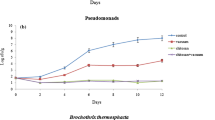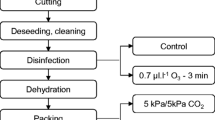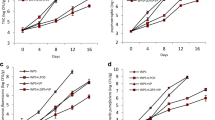Abstract
The aim of the present study was to investigate the effect of different ozone doses (2, 5, and 10 mg/L) on shelf life extension of fresh chicken legs, packaged in polyamide/poleyethylene bags and stored at 4 ± 1 °C, for a period of 12 days. Parameters taken into account were: microbiological (Total viable count, Pseudomonas spp., Lactic acid bacteria, Yeasts and molds, and Enterobacteriaceae), physicochemical (pH, colour) and sensory (odor, appearance, texture, and taste) attributes. Results showed that colour parameter values (L*, a*, and b*) were not affected by the gaseous ozone dose, whereas only L* and b* were reduced during storage in all samples. pH was reduced by storage time but was not affected by ozonation dose and packaging. Total viable count and Pseudomonas spp., increased statistically significant with ozonation dose and storage time, but were not affected by packaging. Yeasts, molds, Enterobacteriaceae, and Lactic acid bacteria, were decreased during storage, packaging and ozonation dose. Finally, sensory examination (appearance, texture, odor and taste) showed that samples treated with ozone concentration of 10 mg/L retained the original characteristic features of fresh chicken legs as compared to the control samples. The gaseous ozone treatment of 10 mg/L for 1 h, to chicken legs packaged in plastic containers of polyamide/polyethylene under refrigeration, is appropriate for maintaining freshness and quality of chicken, since their shelf life was extended by 4 days, as compared to the control samples.

Similar content being viewed by others
References
Adu-Gyamfi A, Torgby-Tetteh W, Appiah V (2012) Microbiological quality of chicken sold in Accra and determination of D10-value of E. coli. Food Nutr Sci 3:693–698
Al-Haddad KSH, Al-Qassemi RAS, Robinson PK (2005) The use of gaseous ozone and gas packaging to control populations of Salmonella infantis and Pseudomonas aeruginosa on the skin of chicken portions. Food Control 16:405–410
Chouliara E, Kontominas MG (2006) Combined effect of thyme essential oil and modified atmosphere packaging to extend shelf life of fresh chicken meat. In: Govil JN, Singh VK, Almad K, Sharma RK (eds) Recent progress in medicinal plants: natural product (15). Studium Press, LCC, USA, pp 423–442
Chouliara E, Karatapanis A, Savvaidis IN, Kontominas MG (2007) Combined effect of oregano essential oil and modified atmosphere packaging on shelf-life extension of fresh chicken breast meat, stored at 4 °C. Food Microbiol 24(6):607–617
Da Silva MV, Gibbs PA, Kirby RM (1998) Sensorial and microbial effects of gaseous ozone on Fish scad. J Appl Microbiol 84:802–810
DIN 53122-2 Water vapor permeability WVTR (electrolysis method), A Mecadi GmbH In der Kolling 966450 Bexbach, Germany
DIN 53380-2 Gas permeability (plastic films manometric), AMecadi GmbH In der Kolling 966450 Bexbach, Germany
FDA (2001) Federal Register, Vol. 66 No.123, June 26 (2001) Department of Health and Human Services, Food and Drug Administration, Rules and Regulations, pp 33829–33830
Fisher CW, Lee D, Dodge B-A, Hamman KM, Robbins JB, Martin SE (2000) Influence of catalase and superoxide dismutase on ozone inactivation of Listeria monocytogenes. Appl Environ Microbiol 66(4):1405–1409
FSIS Directive (2016) 7120.1, Revision 35, safe and suitable ingredients used in the production of meat, poultry, and egg products, May 24, 2016. United States Department of Agriculture Food Safety and Inspection Service, Washington, DC
Guzel-Sydin ZB, Greene AK, Seydin AC (2004) Use of ozone in the food industry. LWT-Food Sci Technol 37(4):453–460
Heetun I, Goburdhun D, Neetoo H (2015) Comparative microbiological evaluation of raw chicken from markets and chilled outlets of Mauritius. J Worlds Poul Res 5(1):10–18
ICMSF (1986) International commission on microbiological specifications for foods. sampling for microbiological analysis: principles and scientific applications, vol 2, 2nd edn. University of Toronto Press, Toronto
Jay JM, Loessner MJ, Golden DA (2005) Modern food microbiology, 7th edn. Springer, New York
Karabagias I, Badeka A, Kontominas MG (2011) Shelf life extension of lamb meat using thyme or oregano essential oils and modified atmosphere packaging. Meat Sci 88:109–116
Khadre MA, Yousef AE, Kim J (2001) Microbiological aspects of ozone applications in food: A review. J Food Sci 6:1242–1252
Leistner L (1995) Principles and applications of hurdle technology. In: Gould GW (ed) New methods of food preservation. Blackie Academic and Professional, London, pp 1–21
Manousaridis G, Nerantzaki A, Paleologos EK, Tsiotsias A, Savvaidis IN, Kontominas MG (2005) Effect of ozone on microbial, chemical and sensory attributes of shucked mussels. Food Microbiol 22:1–9
Muthukumar A, Muthuchamy M (2013) Optimization of ozone in gaseous phase to inactivate Listeria monocytogenes on raw chicken samples. Food Res Int 54:1128–1130
Pohlman FW, Stivarius MR, McElyea KS, Johnson ZB, Johnson MG (2002) The effects of ozone, chlorine dioxide, cetylpyridinium chloride and trisodium phosphate as multiple antimicrobial interventions on microbiological, instrumental color, and sensory color and odor characteristics of ground beef. Meat Sci 61:307–313
purReport (2010) Effect of ozone gas on E. coli O157:H7, Salmonella, and L. monocytogenes on fruit and metal surfaces. Purfresh, Inc., Fremont
Restaino L, Frampton E, Hemphill J, Palnikar P (1995) Efficacy of ozonated water against various food related microorganisms. Appl Environ Microbiol 61(5):3471–3475
Ruban SW, Fairoze D (2011) Effect of processing conditions on microbiological quality of marked poultry meats in Bangalore, India. J Anim Vet Adv 10(2):188–191
Skog LG, Chu CL (2001) Effect of ozone on qualities of fruits and vegetables in cold storage. Can J Plant Sci 81:773–778
USDA Livestock & Poultry (2014) World markets & trade. The poultry site. 30 April 2013. Retrieved 24 Feb 2014
Vaz-Velho M, Duarte G, McLauchlin J, Gibbs P (2001) Characterization of Listeria monocytogenes isolated from production lines of fresh and cold-smoked fish. J Appl Microbiol 91:556–562
Zeynep GS (2003) Use of ozone in the food industry. Food Microbiol 21(4):475–479
Zhang H, Wu J, Guo X (2016) Effects of antimicrobial and antioxidant activities of spice extracts on raw chicken meat quality. Food Sci Hum Wellness 5:39–48
Author information
Authors and Affiliations
Corresponding author
Ethics declarations
Conflicts of interest
All authors declare that they do not have financial, academic, commercial, political or personal interests.
Electronic supplementary material
Below is the link to the electronic supplementary material.
Rights and permissions
About this article
Cite this article
Gertzou, I.N., Drosos, P.E., Karabagias, I.K. et al. Combined effect of ozonation and packaging on shelf life extension of fresh chicken legs during storage under refrigeration. J Food Sci Technol 53, 4270–4277 (2016). https://doi.org/10.1007/s13197-016-2421-7
Revised:
Accepted:
Published:
Issue Date:
DOI: https://doi.org/10.1007/s13197-016-2421-7




